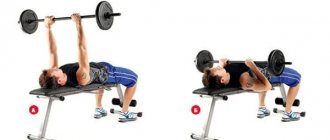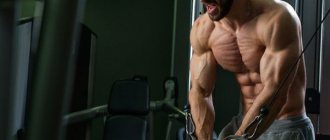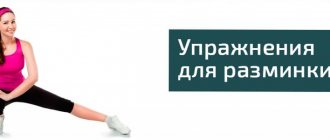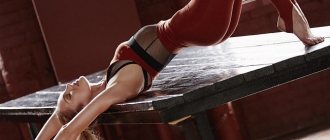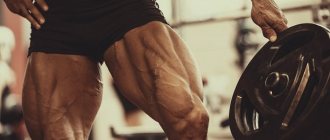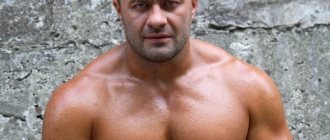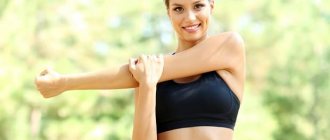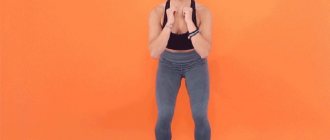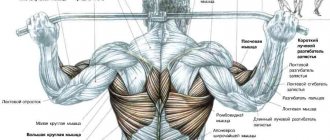The calf muscles grow slowly and are difficult to pump well. But most men and women strive to make their calves sculpted and strong. This is important not only for appearance, but also for endurance during physical activity.
There are special exercises for working this area that are recommended to be performed in the gym. For those who are unable to attend, universal classes at home are suitable. With regular training, this approach is as effective as a professional one, and the minimum equipment and required time to get quick results gives it a significant advantage.
- Step platform
Purpose of training
Before starting classes, it is recommended to set a clear goal that must be adhered to. This will help you see the results from your classes and achieve them quickly. The main goals should be the following:
- eliminating excess fat from the upper and lower legs;
- pumping of muscles in the lower leg area;
- increasing muscle strength necessary for the growth of muscle tissue;
- increase in muscle mass;
- uniform distribution of the load on all muscle groups in order to achieve proportionality throughout the body.
It is difficult for a beginner to achieve large and sculpted shins without fat in a week or a month, but regular exercise and gradually increasing the load will help speed up the process.
Springs
Initial position
Stand up straight, keeping your back straight.
Execution technique
Slowly rise onto your toes, trying to raise your heels as high as possible.
Then the exercise is performed with weights. To do this, simply pick up dumbbells. If it is difficult to maintain balance with two dumbbells, train with one, holding the support with the other hand.
As a more challenging version of this exercise, you can perform it by standing up alternately on one leg and then on the other. Also with weights. Perform 3-4 sets of 30 times.
Recommendations
The exercise must be performed slowly.
Exercises at home
Working out at home allows you to stay fit and build muscle in the right areas without going to the gym . Comfortable clothing and a ventilated room, an exercise mat and dumbbells (for those who have been practicing for a long time and for whom the usual load does not bring results) will be mandatory components. Sports equipment should be purchased at a specialized store.
It is necessary to start the lesson with a warm-up, especially for beginners, girls and boys who are training for the first time. Simple bending of the body, jumping rope, running in place or brisk walking are suitable for this. 7-10 minutes are enough to warm up the muscles and prevent injuries and sprains while performing the main complex. There are several exercises that will be the best for pumping up your calf muscles.
Rise
To perform this exercise, you will need a platform no more than 10 cm high, preferably 5-7 cm. It helps pump up the calves of women and men. Performance:
- Take the starting position - standing on the floor with your arms first straightened along your body.
- Place your socks on the platform, leaving your heels on the floor.
- Spread your legs 15-20 cm.
- Slowly raise your toes, straightening the part of your foot perpendicular to the floor as much as possible.
- After this, also slowly lower your heels to the floor.
To get results, a beginner needs 15-20 lifts; for trained athletes, they should do at least 40 reps. To increase the load, men are allowed to take a dumbbell weighing up to 3 kg each in each hand. Women should not use weights, especially during the first lessons.
Squats
Squats without lifting your heel off the floor are good for training your legs, especially your hips, as well as your gluteal muscles. If you do this on your toes, the calf muscles are perfectly worked out, which allows you to increase the volume of muscle tissue in this area. Performance:
- Take the starting position - standing on the floor with your legs previously spread shoulder-width apart and your arms straight along your torso.
- Squat, lifting your heels off the floor.
- Keep a slow pace to feel the work of the necessary muscles.
Perform from 20 to 50 repetitions depending on the degree of training. Hands can be held in front of you parallel to the floor or pressed to the body, first bent at the elbows. For men, the best option would be to use 2-3 kg of weights in each hand during squats. Women and girls have enough weight of their own body.
With a skipping rope
Jumping rope is popular. Both men and women are allowed to use them. They are suitable for warm-up and main training. An important condition will be maintaining balance and jumping only on your toes, without placing your heel on the floor. This allows you to maximally load the calf muscles, increase their volume and endurance.
For beginners, 3 sets of 2 minutes are enough, the pace is measured. For advanced athletes, it is necessary to perform the exercise at a fast pace and for at least 3 minutes without a break. For a good workout, 3 approaches are enough.
"Spring"
The exercise is reminiscent of simple toe raises while standing on the floor with your legs previously spread shoulder-width apart and your arms spread along your torso. But at the same time, the pace should be accelerated, and as the heel approaches the floor, leave it at a distance of 5-7 mm from it.
As a result of the fast pace, the body seems to spring, and the calf muscles are in constant tension, which allows you to work them out as much as possible and quickly increase volume. After a week of regular use, the first results are visible. Girls and women only need to complete 3 sets of 60 seconds. For men, each approach should be increased by 1 minute.
Walking on your toes
The simplest and most versatile exercise that can be performed at any level of physical fitness. Within a week there will be a visible result. This is a simple walk on your toes every day for 5 minutes. When performing, it is important to keep the raised part of the foot as perpendicular to the floor as possible so that the muscles experience the load.
If this condition is not met, the tension will be insufficient and the volume of muscle tissue will increase very slowly. Trained men are allowed to pick up a dumbbell while walking, each weighing up to 4 kg.
Walking up the stairs
Another universal and simple exercise that is suitable for trained athletes, women and men. It is recommended to perform it every other day. Any steps in the entrance of a multi-storey building or on the street will do. An important condition will be to ascend and descend only on your toes.
5-7 minutes at a moderate pace is enough to increase muscle tissue in the lower legs. There is no need to rush, because in this case the muscles will not be worked well. To increase the load, men are allowed to take 2-4 kg weights in each hand. Girls and women need their own body weight.
Jumping exercises with dumbbells
The exercise is suitable for men and women who have a sufficient level of physical fitness. Girls and beginners should choose another option. Performed similarly to toe squats, but with a weight in each hand. When lifting, you need to make a springy upward movement like a jump or even jump slightly without bending your legs.
It is important to ensure that your back is straight, does not round in the thoracic spine and does not arch in the lower back. For men, a weight of 5 kg is allowed for each hand; for women, 1-2 kg is enough. Perform from 10 to 20 times depending on the level of training.
"Gun"
The exercise consists of squats, but there are some peculiarities when performing them:
- Take the initial position - standing on the floor with your legs previously spread shoulder-width apart and your arms along your torso.
- Raise one leg 20 cm from the floor without bending your knees.
- On the other, squat so that when lowering the body, the raised leg takes a position parallel to the floor.
- Your arms can be pressed to your body, pre-bent or straightened in front of you.
When squatting, the foot is on the toe. This allows you to create maximum tension in the shins. The exercise is suitable for men and women with an average level of physical fitness. 10 squats for each leg are enough.
Run
Running is also a universal exercise and is suitable for women and men. You need to run at least 3 times a week and for at least 20 minutes. In this case, you should not place your heel on the floor or ground, but constantly keep your balance on your toes.
Running is allowed outdoors or at home. It is important to maintain a rhythm and not to strain the muscles too much. Unbearable pain in the shins serves as a signal to stop training until the discomfort completely disappears.
Gait and shoes affect your calves!
Few people know that the influence of posture and gait on the development of the lower leg is much stronger than the effect of training . Flat feet, if not taken into account and not compensated, also prevents the volume of the lower leg from being brought into line with the BB standard (the volumes of the neck, biceps and calves should be equal or close in value). You can pump up your calves without exercise equipment simply by choosing the right shoes and adjusting your gait.
The habit of placing a bent leg on the heel leads to underdevelopment of the calf. If the foot is placed on the toe, the calf will be voluminous even without training. This is explained by the fact that the size of the calf depends not only on the triceps, but also on the muscles that provide finger mobility. If the fingers do not actively participate in walking, their flexors and extensors are underdeveloped. Naturally, their participation in the increase in volume is negligible.
Flat feet or shoes that exclude the work of the toes and ankle, forcing you to walk in such a way that the foot falls on the heel and then rests on the entire surface without rolling, also lead to underdevelopment of the calf.
How to strengthen your lower leg without training or enhance the effect of training
Compliance with these rules in itself leads to the beginning of growth of lagging eggs - make it a habit.
- The gait must be correct. The step is wide, the foot is placed on the toe, then with a roll it falls onto the heel. You need to walk more, at least 5-6 km a day, preferably at an interval pace.
- Shoes should allow your toes to move in them, actively participating in walking.
- If possible during the day, try rocking from heel to toe or standing on your toes.
- Walk barefoot more often.
- The best running is a slow barefoot run on a grassy lawn, sand or forest dirt path. The foot should be placed on the toes and the outer part of the foot with a roll. Running in sneakers has almost no effect on the development of the lower leg muscles.
- Prevention of flat feet is relevant at any age, since with age it can occur in any person. Training from this complex removes the risk of flat feet and always leads to calf growth.
- Special training is performed on the same day as the biceps and quadriceps training, but after them, or the next day - so that large tired muscles do not take over the load from the periphery.
- Training should take into account the Achilles tendon's habit of unloading the triceps. Therefore, the movements are slow, with complete control, with static at the highest point of tension or stretch. A springing effect cannot be allowed when the muscle bellies do not work.
- A set of lower leg exercises must include exercises that involve the toes.
- Sedentary work mechanically injures the femoral biceps and impairs blood supply to the triceps shin (the popliteal blood vessels are pinched). Therefore, it is very important to get up and stretch your legs (a “farmer’s walk” or climbing stairs with support on your toes and active extension of the ankle is ideal).
- Be sure to follow a sleep schedule: if you sleep less than 8 hours, and the day after training you spend on your feet or sit motionless all day on your butt, you can’t hope for hypertrophy. You need to eat right.
Exercises in the gym
Training in the gym is suitable for men and women who have a sufficient level of physical fitness. Girls who have decided to exercise for the first time should not immediately resort to this option, since some exercises are complex and are performed on machines.
When pumping up the calf muscles, pain and discomfort may occur in the area being worked on. This is considered normal. But if the pain intensifies and hemorrhages appear on the skin, you should stop training.
The following are considered the most popular and effective exercises for increasing the size of the calf muscles.
Step platform
A universal and simple exercise that is suitable for trained and unprepared people. Performed on a regular platform 10-20 cm high:
- Take the starting position standing on the floor with your legs previously spread shoulder-width apart.
- Stand with the toe of one foot on the platform, leaving the heel suspended.
- Raise your body on one leg, placing half of your foot as perpendicular to the floor as possible.
- Maintain a steady pace to maximally work your calf muscles.
Perform at least 15 lifts for each leg. If additional support is needed, it is allowed to hold on to a wall or handrail with one hand.
Seated Raises
To perform this exercise, you will need a special exercise machine for pumping your calves, which is available in every gym. It is a kind of chair with a small platform for the legs and a special rod, on which, as you train, you can put weights on, gradually increasing their number.
Execution does not require special skills. You need to sit on the machine and raise your feet on your toes at the same time as the lever on which the weights are located. Depending on the degree of fitness, you should perform from 10 to 30 lifts at a measured pace. Girls should not choose this exercise at the beginning of classes. It is more suitable for men and trained women.
Toe press
For this exercise you will also need a machine called a “leg press”. It consists of a surface for lying on your back, and a special platform on rollers, which must be lifted with your legs up from a lying position. For beginners, the weight of the platform itself is enough. For advanced women and men, it is allowed to add weights in the form of pancakes on each side, which are placed on an iron rod.
It is important to note that lifting should not be done with the entire foot, but only with the toes, this will allow you to maximally pump and increase the volume of the calf muscles. For a beginner, 20 presses are enough; for advanced athletes, up to 50 repetitions are allowed at a measured pace. Girls should not immediately take up such a simulator, since such a load often provokes sprains and injuries due to lack of preparation.
Smith machine
Another machine for pumping calves will be the Smith machine, in which a person squats with a barbell on his shoulders. Regular squats should be replaced with squats on the toes, due to which the effectiveness of the exercise for the legs will increase several times. This option is suitable only for men and advanced women, since the load is serious.
You should start with 10 repetitions, gradually increasing the number to 30 per workout.
Anatomical reference: calf muscles
The calf muscles are easy to visually identify. They are located on the surface of the lower leg, covering part of the soleus muscles. Trained calves look bifurcated, this indicates the specific structure of the muscle: the gastrocnemius consists of two connecting muscle heads - medial and lateral. Their main function is to bend the leg at the ankle and knee joints. In addition, the calf muscle allows you to fix the lower leg in different positions while walking and running. And also the lateral and medial bundles act as arch supports of the foot, i.e. they allow you to change the position of the foot in space.
rpapapapa
The calf muscles allow us to take a step (lift the foot off the floor, hold it) and, therefore, walk, run, swim, jump, dance, ride a bicycle, perform gymnastic tricks and much more. Therefore, it is important to have strong, trained calf muscles not only for the sake of aesthetics, but also for the sake of health, sports achievements, and an active lifestyle.
Main conclusions
It is possible to pump up your calf muscles at home by following these recommendations:
- Work with your own weight at first, gradually increasing the load and using weights.
- Before training, warm up your muscles and joints.
- Spend 1-3 days a week on your calf muscles.
- Follow the technique, perform movements with maximum amplitude.
- Move smoothly.
- Do not lower your heel all the way so that the muscles are constantly tense.
- Gradually increase the number of approaches, reducing the rest time between them.
- Combine sitting and standing exercises, changing the position of your legs to work all muscle groups in your calves.
- Finish your workout with stretching.
If these rules are followed, the athlete will be able to tighten his calves and make them more massive in just a month.
Why don't my calves grow?
The growth of the calf muscles can be limited for a number of reasons:
- The most important factor that limits the growth of the triceps muscle is, of course, anatomical predisposition . Unfortunately, this reason is beyond the athlete’s control. A person with short calves and at the same time long Achilles tendons will not be able to achieve impressive results despite grueling training. Conversely, in people who have long calf muscles and short Achilles tendons, their calves are well-prone to muscle growth;
- Ankle mobility is another reason that greatly affects the development of the triceps muscle. Obviously, the limited range of motion of the calf muscles will not allow you to achieve maximum efficiency from the exercises. Therefore, specific exercises should be included to improve ankle mobility;
- Insufficient load . If the repetition range, frequency and training method are inappropriate, this will also reduce the chance of muscle development;
- Poor nutrition . With a poor diet, the athlete does not receive a huge amount of nutrients that are necessary for the construction of muscle fibers. The production of important hormones (testosterone, growth hormone) responsible for the development of bone and muscle tissue also decreases.
How to choose weight, number of approaches and repetitions
There is an opinion that since the triceps surae muscle consists of endurance fibers of the first type, they need to be pumped with a large number of repetitions. In one experiment B. J. Schoenfeld, A.D. Vigotsky, J. Grgic. Do the anatomical and physiological properties of a muscle determine its adaptive response to different loading protocols? / Physiological reports decided to check whether calves really grow better from repeated repetitions, and found out that this is not the case.
In the study, 26 untrained young men were divided into two groups. Some performed 4 sets of 6–10 repetitions of standing and sitting calf raises, others performed 4 sets of 20–30 repetitions.
Both groups worked until their muscles failed. That is, in each approach they were hammered so hard that they could not complete a single more repetition. After 8 weeks, the scientists saw that the calf muscles in both groups grew about the same.
It doesn’t really matter whether you do 20–30 repetitions or 6–10. The main thing is that each approach is performed to muscle failure or very close to it.
Choose one or alternate long and short approaches so that you don’t get bored. If you're working without weights, it may take at least 30 smooth reps with tension at the top to really hammer your calves.
As for the number of approaches, start with 2-3 to gradually get used to the load and not damage the muscles too much in the first sessions. As you get used to it, you can increase the number of sets to 4–5.


